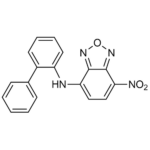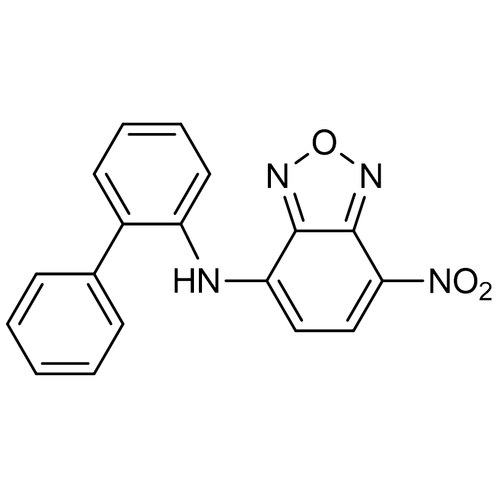| Product Name | 10074-G5 |
| Description |
c-Myc inhibitor |
| Purity | >98% (TLC); NMR (Conforms) |
| CAS No. | 413611-93-5 |
| Molecular Formula | C18H12N4O3 |
| Molecular Weight | 332.3 |
| Field of Use | Not for use in humans. Not for use in diagnostics or therapeutics. For in vitro research use only. |
Properties
| Storage Temperature | -20ºC |
| Shipping Temperature | Shipped Ambient |
| Product Type | Inhibitor |
| Solubility | May be dissolved in DMSO (40 mg/ml) |
| Source | Synthetic |
| Appearance | Orange powder |
| SMILES | C1=CC=C(C=C1)C2=CC=CC=C2NC3=CC=C(C4=NON=C34)[N+](=O)[O-] |
| InChI | InChI=1S/C18H12N4O3/c23-22(24)16-11-10-15(17-18(16)21-25-20-17)19-14-9-5-4-8-13(14)12-6-2-1-3-7-12/h1-11,19H |
| InChIKey | KMJPYSQOCBYMCF-UHFFFAOYSA-N |
| Safety Phrases |
Classification: Danger. Hazard Statements H301 (100%): Toxic if swallowed [Danger Acute toxicity, oral] H315 (100%): Causes skin irritation [Warning Skin corrosion/irritation] H319 (100%): Causes serious eye irritation [Warning Serious eye damage/eye irritation] H335 (100%): May cause respiratory irritation [Warning Specific target organ toxicity, single exposure; Respiratory tract irritation] Precautionary Statement Codes:, P261, P264, P264+P265, P270, P271, P280, P301+P316, P302+P352, P304+P340, P305+P351+P338, P319, P321, P330, P332+P317, P337+P317, P362+P364, P403+P233, P405, and P501 |
| Cite This Product | 10074-G5 (StressMarq Biosciences Inc., Victoria BC CANADA, Catalog # SIH-609) |
Biological Description
| Alternative Names | 7-Nitro-N-(2-phenylphenyl)-2,1,3-benzoxadiazol-4-amine |
| Research Areas | Alzheimer's Disease, Amyloid, Epitope Tags, Myc Tag, Neurodegeneration, Neuroscience, Tags and Cell Markers |
| PubChem ID | 2836600 |
| Scientific Background | 10074-G5 binds to and distorts the bHLH-ZIP domain of c-Myc, thereby inhibiting c-Myc/Max heterodimer formation and inhibiting its transcriptional activity (1). 10074-G5 is capable of binding and sequestering the intrinsically disordered amyloid-β (Aβ) peptide in its monomeric, soluble state. Our analysis reveals that this compound interacts with Aβ and inhibits both the primary and secondary nucleation pathways in its aggregation process (2). |
| References | 1. Follis A.V. et al. (2008) Chem. Biol. 15: 1149. 2. Heller G.T. (2020) ScienceAdvances. 6(45): DOI: 10.1126/sciadv.abb5924. |



StressMarq Biosciences :
Based on validation through cited publications.